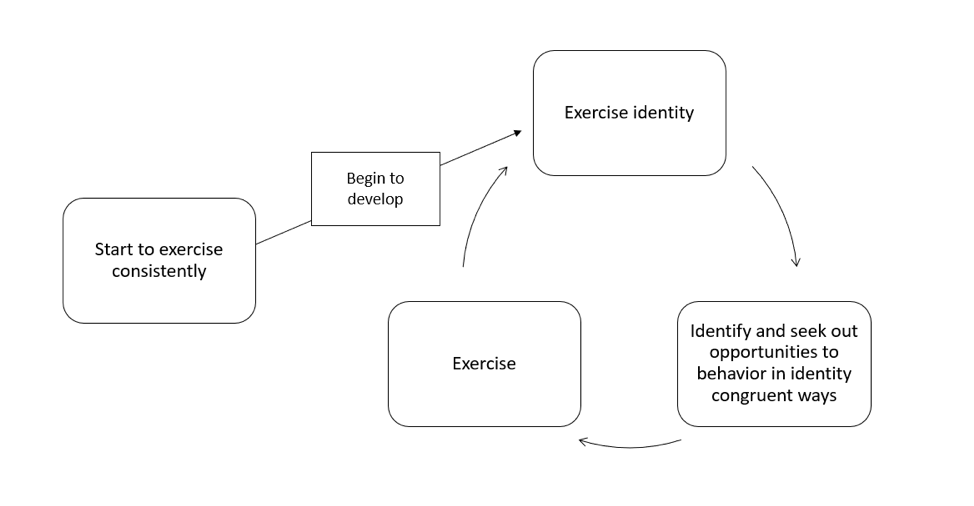Most personal trainers, at some point, will have a consultation with a client who has a weight loss goal. For a few weeks, I had one of my clients message me everything they ate along with their exercise routine outside of the gym. We're talking times, foods, estimated caloric consumption, time spent doing exercise along with daily weigh-ins. When you do this, you start to notice habits and patterns that can be adjusted. Maybe this person does well most of the time but has big dinners that thwart weight loss efforts. Perhaps they don't exercise outside of the gym. Regardless of what the issue is, tracking provides the primary metrics for a change strategy.
But change is exceptionally challenging. Many people base behaviors upon relatively stable routines. Practices are the result of how we define ourselves. If you identify yourself as someone good with money, you don't go out spending hundreds of dollars per week on shoes. If you view yourself as family-oriented, you don't spend extra hours in the office. You are at home with your family. Behaving in such identity discrepant ways causes inner conflict.
If a person has failed to incorporate health and fitness into their identity, behaviors may be sporadic at best and meaningless at worst. What does four or five cookies mean if you don't define yourself as a healthy person? Healthy people exercise because that is a part of who they are. They eat fruits and vegetables because that is what healthy people do. If health is not a part of a person's identity, there is a lack of congruence between healthy or unhealthy things they may do and the meaning behind these behaviors.
After I recognized some habits this client had
that could lead to significant improvement, we sat down and had a meeting.
After we discussed some of the things this client could work on, I asked him
one question:
"How does being
healthy fit into your identity?"
He was stumped. He had never even thought about this question. "I don't know… I guess it's not," he said. I explained to him that identity gives meaning to behaviors. Identity drives long term maintenance of behavior and behavior is what drives health success or lack thereof. When we incorporate 'exercise' into our identity, we behave like an 'exerciser.' If that were in place, nothing would stop clients from acting in such a goal congruent way. Without a doubt, personal trainers will rarely, if rarely run into new clients who have incorporated exercise into their identity. If they had done this already, then they wouldn't be seeking out help, especially not in the long run. However, no need to fret if a client doesn't have an answer for you. Just ask them the same question I asked my client:
"What comes first,
identity, or behavior?"
What is Identity?
Identities define how we see ourselves in any
given role. Identity serves as the guideline for personal standards upon how we
act. Past experiences and previous behavior form them.
Identity sets the standard for how we behave; we seek to behave in ways that align with our identity. The benefit of having an exercise identity is that when we act in identity aligning ways, we strengthen our identity. In a sense, identity can be the basis for the most positive self-fueling feedback loop a client can have.

Therefore, it is not a pressing nor surprising
issue if a client does not identify as an exerciser. The first step is to get
them started because behavior is what fuels identity.
It is useful, upon an initial consult, to
identify how to measure identity and to also have knowledge of how to cultivate
and nourish an exercise identity.
How Do We Measure Identity?
A personal trainer may be interested in
measuring identity for exercise and healthy eating. Measuring this can be a
part of an initial consultation. While there certainly is merit to merely
asking a client how training fits into their identity, we don't know if the
client is progressing unless we take quantitative measurement of the construct.
The following are three questions to assess
nutrition identity and also three questions to evaluate exercise identity.
Nutritional Identity
How would you describe
your eating identity?
- I am an unhealthy eater
- I am a somewhat
unhealthy eater - I am somewhere in
between an unhealthy eater and a healthy eater - I am a somewhat healthy
eater - I am a healthy eater
I am someone who eats in a nutritious manner.
- Strongly disagree
- Slightly disagree
- Neutral statement for
me, do not necessarily agree or disagree - Somewhat agree
- Strongly agree
How would you describe
your eating?
- I am never careful about
what I eat - I am very rarely
cautious about what I eat - I am seldom careful
about what I eat - I am occasionally
careful about what I eat - I am very frequently
careful about what I eat - I am always careful
about what I eat
Exercise Identity
I consider myself an exerciser.
- Strongly disagree
- Slightly disagree
- Neutral statement for me, do not necessarily agree or disagree
- Somewhat agree
- Strongly agree
When I describe myself to others, I usually include my involvement in exercise.
- Strongly disagree
- Slightly disagree
- Neutral statement for me, do not necessarily agree or disagree
- Somewhat agree
- Strongly agree
Others see me as someone who exercises regularly.
- Strongly disagree
- Slightly disagree
- Neutral statement for me, do not necessarily agree or disagree
- Somewhat agree
- Strongly agree
Along with the open-ended question, “how is
exercise/ healthy eating a part of your identity” these metrics can provide the
basis for a meaningful dialogue with your client.
How Do We Promote Exercise Identity?
This is the question that matters most. Once we
have assessed it, how can we enhance it? Self-Determination Theory is a broad
theory that seeks to understand and describe motivated behavior. One sub theory
within Self-Determination Theory describes different motives for behavior that
exist on a continuum, with some reasons being more controlled and other reasons
being more autonomous.
Behaviors occur due to different regulations or
motives. Externally regulated behaviors occur to satisfy an external
demand or possibly a reward. These actions do not happen because a person wants
to but rather because something or someone else is making them. Introjected
regulation involves a person taking action for reasons such as guilt,
anxiety, or to enhance ego. Introjected regulation and external regulation are
controlled forms of motivation. These aren't good foundations for long term
behavior.
Identified regulation, on the other hand, reflects a valuing of the behavior. Maybe the
goal of attaining health is vital to that person. Another form of regulation is called integrated
regulation. People are said to have integrated regulation when the behavior
assimilates into who the person is. It fulfills their values and their needs.
It is part of their identity.
Self-Determination Theory also provides
direction on how to help individuals fulfill their basic psychological needs.
These needs include the need to feel competent, the need to feel autonomy
(i.e., not forced to do a behavior they do not want to do), and the need to
feel relatedness (cared for).
Personal trainers should work to establish
environments that meet a client's basic psychological needs around exercise. You
can accomplish competency by helping clients feel that they can successfully
execute different exercise-based challenges. If you introduce a new client to a
complex movement such as a loaded back squat on day one, there is a low
probability that they will feel competent. Recognize improvements with
affirmations that highlight the hard work clients put in.
Autonomy should be respected so that clients
don’t do exercises they do not enjoy doing, even if the personal trainer thinks
it will benefit them. Exercises are just tools to get the job done. There are a
variety of tools to get the same job done. Personal trainers should fit
exercises to their clients, not clients to exercises.
The last component, relatedness, can be developed by fostering community. Staff members should be friendly, support the client's goals, and make them feel cared for. Gyms and studios should work to develop a "third space" environment for their clients. This environment is a unique, communal space that is separate from home or work. It is a place where individuals can build relationships with others while still expressing their sense of identity. The gym should feel like clients home away from home. Fostering community is the last way to help clients fulfill their needs and develop an exercise-based identity.
For more ways to implement positive behavioral changes with your clients, become an NASM Behavior Change Specialist.
And check out these additional blog posts on the subject:
















